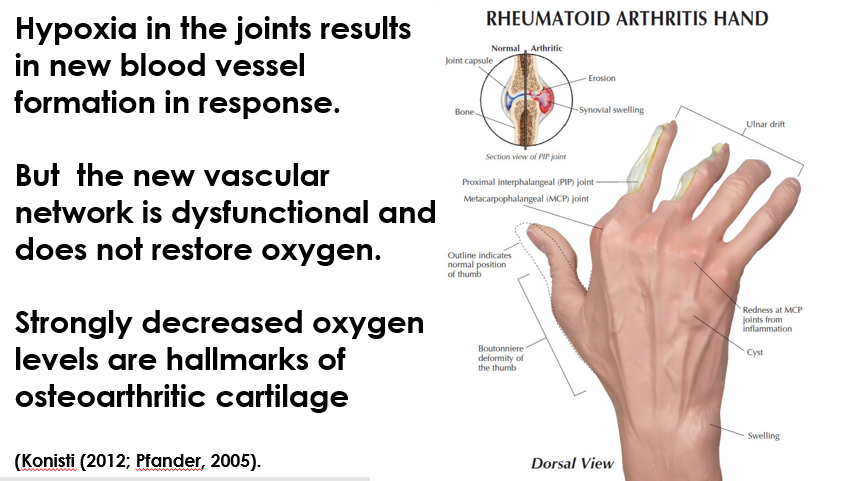
As one ages, normal wear and tear of the joints can result in inflammation, causing osteoarthritis. Rheumatoid arthritis is the result of an immune system attack on the body, affecting the soft tissues in your joints. Why this occurs is currently unknown. Rheumatoid arthritis can eventually lead to the destruction of the bone and cartilage within the joints. The primary goal of treatment is to reduce the pain associated with arthritis, and prevent additional joint damage. As noted in research on tai chi, reduction of pain is uniform across studies for various conditions, including arthritis.
Like many other chronic conditions (including heart, lung and kidney disease, cancer, diabetes, compromised immunity, asthma and many other conditions), arthritis is also aggravated by hypoxia (oxygen deficiency reaching the tissues). Metarobic theory and research supports that one of the primary factors in the benefits of tai chi for arthritis is its effects on hypoxia. This also includes benefits of other breath-focused relaxation exercises, including forms of yoga and qigong. One of the hallmarks of rheumatoid arthritis is the development of new capillary blood vessels (or angiogenesis) in the joints. Research suggests that this may be a result of increased hypoxia (oxygen deficiency).
Dr. Konisti and colleagues reported new research which indicates that inadequate oxygenation (hypoxia) in the joints results in an increase in new blood vessels (which may be an attempt by the body to reduce hypoxic areas), resulting in inflammatory cells. Doctors. Taylor and Sivakumar noted that new blood vessel formation results in a dysfunctional vascular networks, which being dysfunctional, do not restore tissue oxygen and results in hypoxia. Inflammation also plays a role in Osteoarthritis, which occurs when the cartilage that cushions the joints wears away. Dr. Pfander and colleagues, in their research on the role of hypoxia in osteoarthritis, state that strongly decreased oxygen levels are hallmarks of osteoarthritic cartilage.
From a Metarobic perspective, all of the case stories reporting significant benefits for various forms of arthritis may be due to effects on reversing hypoxia. The Metarobic effect is the increase in blood oxygen saturation, diffusion, and oxygen metabolism, which occurs during slow breath focused exercises. This includes mindful exercises such as tai chi, qigong and forms of yoga. Preliminary evidence suggests that Metarobic effects may reverse or reduce hypoxia. Enhanced blood and oxygen circulation and diffusion may also affect and reduce (or eliminate) formation of excessive blood vessels, and the resulting synovial angiogenesis. This would explain the reversal of arthritis symptoms in the case stories presented on the Metarobic Facebook page, and documented in my book. Further research would need to confirm this link, but from a theoretical perspective, it would explain the large number of people reporting benefits from tai chi and related exercises (including people confined to a wheel chair, who regained the ability to walk – see my book Mindful Exercise: Metarobics, Healing, and the Power of Tai Chi for more research, case stories, and details).
Last year I posted studies on tai chi which reported significant benefits for those with arthritis. Following are some studies related to qigong. Drs. Chen and Liu, with the University of Medicine and Dentistry in New Jersey, and the Beijing University of Chinese Medicine, conducted a review of 11 studies which used qigong for arthritis. The authors note that from a Traditional Chinese Medicine perspective, arthritis is caused by blocked qi flow. This makes sense, since the literal translation of qi is “air” or “oxygen.” The doctors noted that qigong practitioners have more efficient oxygen metabolism and a slower heart rate than non-practitioners.
The authors note one particularly large study in which qigong therapy was provided to 295 rheumatoid arthritis patients who had not responded to conventional treatment (drugs). Participants practiced standing qigong every day, and also underwent acupuncture treatment. Two months, later 192 patients reported complete recovery from all arthritis symptoms (pain, impaired joint function, erythrocyte sedimentation rate (ESR), and rheumatoid blood factor) They were still symptom free at the sixth month follow-up. Eighty-three patients experienced significant improvement in symptoms (no pain, but joint function was still slightly limited and ESR was still elevated). Fourteen patients reported some benefits for pain relief and movement. The authors also cited other studies with smaller numbers of patients which supported these benefits. Metarobic theory presents an evidence-based explanation of benefits. It can be hoped that with time and further research, Metarobic exercises can be maximized to result full relief of arthritis and other conditions. Dosage may be a key factor, and it would need to be addressed if the 192 patients who reported total elimination of arthritis symptoms were more diligent in their practice.
Primary References
Henrotin Y, Pesesse L, Lambert C. Targeting the synovial angiogenesis as a novel treatment approach to osteoarthritis. Ther Adv Musculoskelet Dis. 2014 Feb; 6(1): 20–34.
Pfander D, Cramer T, Swoboda B. Hypoxia and HIF-1α in osteoarthritis. Int Orthop. 2005 Feb; 29(1): 6–9.
Chen KW, Liu T. Effects of Qigong Therapy on Arthritis: A Review and Report of a Pilot Trial. Medical Paradigm. 2004: 1(1): 1-14
Konisti S, Kiriakidis S, Paleolog EM. Hypoxia--a key regulator of angiogenesis and inflammation in rheumatoid arthritis. Nat Rev Rheumatol. 2012 Jan 31;8(3):153-62..
Taylor PC, Sivakumar B. Hypoxia and angiogenesis in rheumatoid arthritis. Curr Opin Rheumatol. 2005 May;17(3):293-8.
Arthritis Foundation. Rheumatoid Arthritis Causes. https://www.arthritis.org/about-arthritis/types/rheumatoid-arthritis/causes.php
Butler N, Macon BL, Reed-Guy L. Arthritis. Healthline.com https://www.healthline.com/health/arthritis.
 RSS Feed
RSS Feed